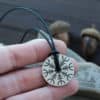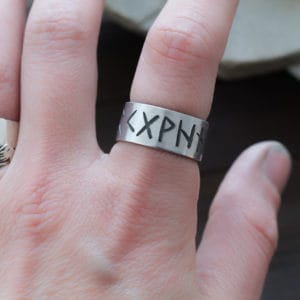No products in the cart.
Helm of Awe Pendant
$31.00 – $64.00Price range: $31.00 through $64.00
$24.80 – $51.20Price range: $24.80 through $51.20
Handcrafted Aegishjalmur pendant symbolizing Viking strength. A timeless blend of history and artistry.
SKU: N/A
Categories: Best Sellers, For Men, For Women, Helm of Awe, Helm of Awe Necklace, Necklaces, Norse Pagan Jewelry, Pagan Jewelry, See All Jewelry, Viking Jewelry
Norse Helm of Awe Pendant Silver
Made in your choice of metal

Hand fabricated pendant from your choice of fine silver, aluminum, copper or brass – this timeless Viking protection symbol takes on a modern aesthetic with a hole in the center and a mirrored polish.
- 1 inch in diameter
- Rests on a 25 inch black cotton cord
Helm of Awe Origin & History
Viking Symbols: Helm of Awe Meaning
The Helm of Awe, known as Aegishjalmur in Old Norse, is one of the most powerful and mysterious symbols in Norse mythology. Often depicted as an eight-armed figure radiating out from a central point, it’s believed to offer protection and mental fortitude. Vikings would inscribe this symbol on their foreheads, believing it would protect them in battle and make them invincible to their enemies.
Runes Around Helm of Awe: Their Significance
The runes surrounding the Helm of Awe are not just decorative; they hold deep significance. Each rune represents a different aspect of Norse cosmology and belief. For instance, some runes might symbolize strength, others might represent protection, and some could denote wisdom. When combined with the Helm of Awe, these runes amplify the symbol’s power, making it a potent emblem of protection and spiritual strength.
What Does Helm of Awe Mean in Norse Culture?
In Norse culture, the Helm of Awe held a revered place. It wasn’t just a symbol; it was an embodiment of the Vikings’ spirit and their warrior ethos. The Helm of Awe was believed to protect its wearer, not just from physical harm, but also from mental and spiritual threats. It was a symbol of invincibility, resilience, and an unwavering spirit. Beyond its protective qualities, it also represented a deep connection to the Norse gods and the greater cosmos, reminding its wearer of their place in the vast tapestry of existence.
Helm of Awe Pagan Significance
Helm of Awe Symbol Meaning in Pagan Rituals
In pagan rituals, the Helm of Awe was more than just a symbol of protection; it was a conduit to the divine and the forces of nature. Pagans believed that by inscribing or wearing the Helm of Awe, they could tap into the energies of the universe, drawing strength, courage, and clarity. Rituals often involved chanting, meditation, and the use of the Helm of Awe symbol to invoke its power. It was seen as a tool to enhance spiritual connection, ward off negative energies, and guide practitioners in their spiritual journey.
Connection to Other Pagan Symbols
The Helm of Awe shares connections with several other pagan symbols, each holding its unique significance. For instance, the Vegvisir, often referred to as the Viking compass, is another stave that ensures one never loses their way, be it in physical journeys or spiritual quests. Similarly, the Ouroboros, a serpent eating its tail, resonates with the Helm of Awe’s themes of eternal protection and cyclical nature of life. These symbols, when used in conjunction with the Helm of Awe, amplify its power and meaning, creating a rich tapestry of pagan beliefs and practices that intertwine and enhance each other.
Origins...
The Völsunga Saga written in the 13th Century of unknown origin, is based on Old Norse poetry. Today, many old Norse poems are compiled and collected in the Icelandic Konungsbók, also known as Codex Rexius.
In the Völsunga saga, we learn that Sigurd and Regin went to a place called the glittering Heath, where they were waiting for the Dragon Fafnir. Fafnir appeared and did drink from a river when Sigurd attacked and killed the dragon.
Sigurd was told that Regin would take all of the treasures himself and thus killed Regin. Sigurd cut the heart out of the dragon and ate it. He found the treasures like the sword Hrotti and Aegishjálmr ( called the Helm of Awe, also Aegishjalmr).
The Helm of Awe is one of many items that belong to the Galdrastafir, staves and and sigils with spiritual effects. To the farmers and homesteaders of Iceland, these symbols were most likely important for cultural and spiritual reasons.

We learn in the Huld Manuscript of Galdrastafir (Hulda = secrecy) about many of such sigils, although from a heavily christianized point of view, written by Geir Vigfússon in 1860. The Helm of Awe was used for protection, strength and endurance, to prevail inner and outer battles, and to make ones enemies feared.”
| Choice of Metal | Aluminum |
|---|---|
| Metal | Aluminum, Brass, Copper, Fine Silver |
Customer Reviews
5.0 Based on 1 Reviews
5 ★
100%
1
4 ★
0%
0
3 ★
0%
0
2 ★
0%
0
1 ★
0%
0
Customer Photos
- Reviews
- Questions
Thank you for submitting a review!
Your input is very much appreciated. Share it with your friends so they can enjoy it too!
Be the first to review this item
Filter Reviews:
×
Clear filter
More Filters
MB
05/23/2018
Matt B.
US
Amazing!
I love this necklace. Nicely made! Great job!
Related products
-

Custom Rune Ring – Cuff Style
$27.00 – $73.00Price range: $27.00 through $73.00
$21.60 – $58.40Price range: $21.60 through $58.40 Select options This product has multiple variants. The options may be chosen on the product page -

Custom Silver Rune Ring – Rustic
$114.47$91.58 Add to cart -

Moose Ring – Tribal – Custom Rune
$319.72$255.78 Add to cart -

Troll Cross Bracelet – Copper or Silver
$40.00 – $66.00Price range: $40.00 through $66.00
$32.00 – $52.80Price range: $32.00 through $52.80 Select options This product has multiple variants. The options may be chosen on the product page
Amazing! The Jörmungandr ring is thick and weighty. At 2mm, I was worried it would be too thick. That is not the case at all. Even its heft, which feels great in the hand, is not tiring on my finger.
Jacqueline is super responsive to messages and very helpful. Idk what else I need from her shop, but I’m convinced whatever it is will be brilliant!
0.0
0 Reviews
Amazing! The Jörmungandr ring is thick and weighty. At 2mm, I was worried it would be too thick. That is not the case at all. Even its heft, which feels great in the hand, is not tiring on my finger.
Jacqueline is super responsive to messages and very helpful. Idk what else I need from her shop, but I’m convinced whatever it is will be brilliant!
0.0
0 Reviews

Over 6,000 5 star reviews on Etsy!

Handcrafted by me for you and shipped in 1-2 weeks 🙌













